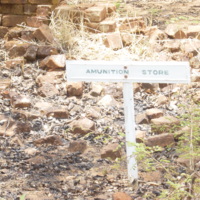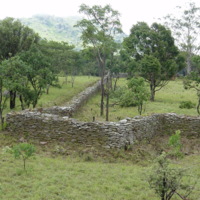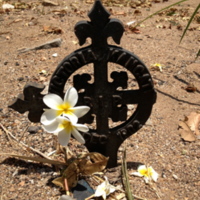Fort Lister
Description:
1893-1902. Well preserved ruins on top of the pass between Mulanje and Mchesi mountains. The Fort was built to counter slave trade activities by some Yao chiefs in the Shire highlands who used the pass as a route to the Indian Ocean. It is on top of the pass between Mulanje and Mountain and Michesi Hill. It was an important Slave Trade Route used by Yao chiefs among whom were Mkanda, Matipwiri, Nyezerera and Kawinga. The Fort was built by Sir Harry Johnston in 1895 and named after Sir Harry Vilkers Lister of the Foreign Office. The environmental setting remains the same as it has been the time the forts were built, the same brachystegia trees remains within the property, no human encroachment has occurred.
Mt. Zion
Description:
1888 Presbyterian mission site on the hill above the Phalombe-Mulanje road. Robert Cleland, from Monklands in Scotland, visited the area in 1888-1889 to climb the mountain. He was warned that strange people lived up there, who had no communication with the outside world. He was the first foreigner to discover the Mulanje cedar. He died a year later, in 1890, of Blackwater Fever. In 1891 Dr Scott took up the work and a site was established at Linje in Chief Namonde’s area. Scott chose a second site at the foot of Chilemba peak near the source of the Linje stream, which is where the CCAP Hope Rest Cottage is to this day. In 1893 the Mission received title to the land. The Cleland Memorial Chapel was opened in 1899 at the Mission, also known as Mt Zion. Built of burnt bricks and grass thatch, and with a spire which was said to be the very first of its kind in central Africa. By 1904 the Chapel was attracting a congregation of 200, the school had seven year groups, and there were various industrial craft projects. Boarding houses and District churches were established. However by the early 1930s the Mission moved to a larger site on the main Mulanje/Mozambique road.
Fort Anderson
Description:
Built to counter the slave trade. At the confluence of the Muloza and Ruo rivers, on the site of what is now Mulanje town.
Nguludi Slave House
Description:
Built between 1880 and 1890 by Donald Matola, it was used as a depot for slaves being transported to Chiwambo on the Indian Ocean. And also as a depot for forced labourers (Thangata) to work in farms within the Shire Highlands. Malota was a good labour recruiter for the settlers in the area and the name could easily derive from his legitimate labour activities
Fort Mangochi
Description:
On Mangochi Mountain. Originally the stronghold of Jalasi the slave trader, the British turned it into a Fort after defeating Jalasi in 1895. Built in 1897 by the British. It relates to: - the slave trade and its abolition -The migration and settlement of the Yao -Military history of Malawi. -The most well preserved slave trade structure in Central-East Africa. Its strategic and picturesque location on a mountain top offers a commanding view of the valleys and plains up to Mozambique. The environmental setting remains the same as it has been the time the fort was built, no human encroachment has occurred.
Fort Alston
Description:
Built in 1896, on the Nkhotakota road. This fort was built by the British to deter Slave traders bringing slaves from Zambia to Nkhotakota from where used to get shipped to the East African Slave Market of Kilwa. LOCATION TBC
Fort Manning
Description:
Built 1897.This fort was constructed by the British to deter Slave traders from bringing slaves from Zambia to Nkhotakota from where they used to get shipped to Slave Markets of Kilwa.
Livingstone tree
Description:
At this tree Dr. Livingstone negotiated with Jumbe regarding freedom for slaves. One of major Slave Trade Routes was Nkhotakota where a Swahili-Arab slave trader, Salim-bin Abdullah (Jumbe) set up his headquarters on the shore of Lake Malawi in the 1840s. From Nkhotakota he organized his expeditions to obtain slaves and ship them across the lake to East African markets, Kilwa. About 20, 000 slaves (Pachai, P.A. 1968) were annually shipped by Jumbe to Kilwa from Nkhotakota. The captives were kept until they number 1000 and taken across the lake and then forced to walk for three to four month journey to Kilwa where they were sold.
Jumbe Mosque and Grave
Description:
Built by Jumbe, the Arab slave trader, who settled in Nkhotakota between 1840s-1895. This is the first mosque to be built in Malawi. It relates to the coming in of Islam, Islamic culture and also the impact of slave trade in Malawi. Ruins of Jumbe's mosque are still existing but Jumbe's grave has been eroded as lake levels have risen. Local guides can be found to take you on a walking tour.
Nkhotakota Livingstone tree
Description:
1861 Dr Livingstone met Jumbe under the tree and again in 1864 Livingstone met Jumbe and Chewa chiefs here again to negotiate a treaty to end hostility and cease slave trading.
Fort Hill
Description:
Ruins within Chitipa town, which was once a British fort built to deter Slave traders, especially Mlozi.



